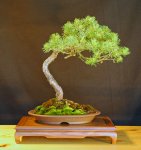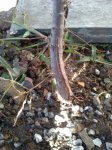Vance Wood
Lord Mugo
 I have dealt with this issue for many years, through trying them, researching those who have written about them, and seeing the results, or lack of them, in many cases. It is possible to do this stuff but if you are going to do it you need to know what happens when you do. First off, you hammer deciduous, you do not slice them. Secondly you slice or penetrate the bark on Pines you do not hammer them. You do not do either one on Junipers. Junipers do not heal wounds to the bark they just grow around them. If you do anything to a Juniper it has to be a slice that must follow a growth line.
I have dealt with this issue for many years, through trying them, researching those who have written about them, and seeing the results, or lack of them, in many cases. It is possible to do this stuff but if you are going to do it you need to know what happens when you do. First off, you hammer deciduous, you do not slice them. Secondly you slice or penetrate the bark on Pines you do not hammer them. You do not do either one on Junipers. Junipers do not heal wounds to the bark they just grow around them. If you do anything to a Juniper it has to be a slice that must follow a growth line. If you have a complete collection of Bonsai Today and a collection of International Bonsai (Bill's magazine) I would highly recommend searching through them for anything written about Kimura. He has used a technique of punctuering the trunk down to the cambium layer. You use a very fine awl or even a dental pick and push it into the bark until it hits something hard. Do this as many time as you can. I have done this and it does work but it does take time. Do this on Pines. I have seen hammering thicken Maples but you have to be careful. Understand that you are injuring the tree and the cambium layer beneath the bark. You are forcing it to respond to heal itself and this causes a swelling. I have one Scots Pine that I performed this method on a number of years ago. I will post the picture if I can find them. I lost the tree two years ago in the record setting winter we had.
I found the photo from 2006. The base of the trunk had an inverse taper. I used the puncture technique to resolve much of it.
Last edited:





